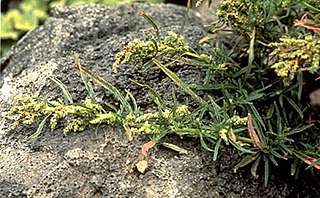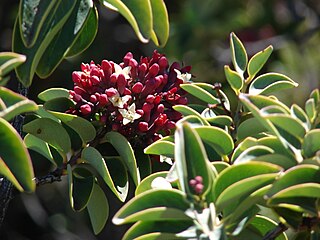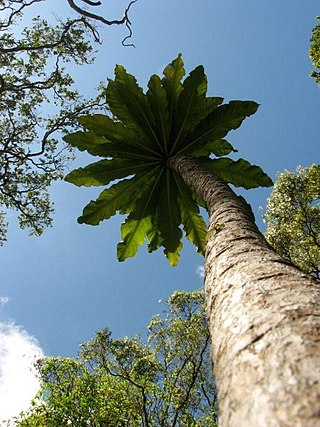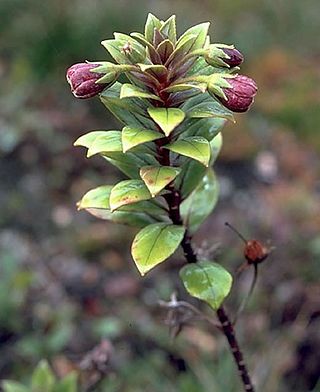
Geranium is a genus of 422 species of annual, biennial, and perennial plants that are commonly known as geraniums or cranesbills. They are found throughout the temperate regions of the world and the mountains of the tropics, with the greatest diversity in the eastern part of the Mediterranean region.

Linum (flax) is a genus of approximately 200 species in the flowering plant family Linaceae. They are native to temperate and subtropical regions of the world. The genus includes the common flax, the bast fibre of which is used to produce linen and the seeds to produce linseed oil.

Pelargonium is a genus of flowering plants that includes about 280 species of perennials, succulents, and shrubs, commonly called geraniums, pelargoniums, or storksbills. Geranium is also the botanical name and common name of a separate genus of related plants, also known as cranesbills. Both genera belong to the family Geraniaceae. Carl Linnaeus originally included all the species in one genus, Geranium, and they were later separated into two genera by Charles Louis L'Héritier de Brutelle in 1789.
Hawaiian hibiscus are seven species of hibiscus native to Hawaii. The yellow hibiscus is Hawaii's state flower. Most commonly grown as ornamental plants in the Hawaiian Islands are the non-native Chinese hibiscus and its numerous hybrids, though the native Hibiscus arnottianus is occasionally planted.

Abutilon menziesii, known as Koʻoloaʻula in Hawaiian, is an endangered species of flowering shrub in the mallow family, Malvaceae, that is endemic to Hawaii.

Amaranthus brownii was an annual herb in the family Amaranthaceae. The plant was found only on the small island of Nihoa in the Northwestern Hawaiian Islands, growing on rocky outcrops at altitudes of 120–215 m (394–705 ft). It was one of nine species of Amaranthus in the Hawaiian Islands, as well as the only endemic Hawaiian species of the genus. It is now considered extinct.

The Alakaʻi Wilderness Preserve, popularly known as Alakaʻi Swamp, is a montane wet forest on the Hawaiian island of Kauaʻi. Although the preserve is home to alpine bogs, it is not a true swamp. It is located on a plateau near Mount Waiʻaleʻale, one of the wettest spots on Earth. Due to its unique combination of high elevation and climate, the Alakaʻi Swamp harbors a large number of endangered endemic species that are only found in this area and whose population has been dramatically declining over the last decades. It is designated as a IUCN protected area.
Psychotria grandiflora, the largeflower wild coffee, large-flowered balsamo or kopiko, is a species of plant in the family Rubiaceae endemic to the island of Kauai in the Hawaiian Islands. It grows in rainforest habitat. There are ten small populations remaining, with a total of no more than 30 individuals. This plant was federally listed as an endangered species of the United States in 2010.

Santalum haleakalae, known as Haleakala sandalwood or ʻIliahi in Hawaiian, is a species of flowering tree in the sandalwood family, that is endemic to the islands of Maui, Lanai, and Molokai in the Hawaiian Islands, part of the United States. It grows in subalpine shrublands at elevations of 1,900 to 2,700 m, especially on the slopes of Haleakalā.

The Loch Lomond Vernal Pool Ecological Reserve is a nature reserve of 8.22 acres (33,300 m2) in the community of Loch Lomond in Lake County, California. It is one of 119 ecological reserves managed by the California Department of Fish and Game (CDFG). The ecological reserve system was authorized by the state legislature in 1968 for the purpose of conservation and protection of rare plants, animals and habitats.

Argyroxiphium sandwicense subsp. sandwicense, the Mauna Kea silversword, is a highly endangered flowering plant endemic to the island of Hawaiʻi of Hawaii. It is the "crown jewel" of the volcanic mountain Mauna Kea, from which it derives its English name. The Hawaiian name is ʻahinahina; it applies to silverswords more broadly. The Mauna Kea silversword was once common on the volcano, and extraordinary conservation efforts are being made to preserve the species.

Charpentiera densiflora is a rare species of tree in the family Amaranthaceae known by the common names dense-flowered pāpala and Nā Pali Coast pāpala. It is endemic to the island of Kauai in Hawaii, where there are 300 to 400 mature trees remaining. This and many other rare Kauaian plants were added to the endangered species list of the United States in 2010.

Cyanea superba is a rare species of flowering plant in the bellflower family known by the common names Mt. Kaala cyanea and superb cyanea. It is endemic to the island of Oahu, but it is now extinct in the wild. It exists in cultivation and some individuals have been planted in appropriate habitat. It is a federally listed endangered species of the United States. Like other Cyanea it is known as haha in Hawaiian.
Dubautia kenwoodii, the Kalalau rim dubautia, is an "extremely rare" species of flowering plant in the family Asteraceae. It is endemic to Hawaii where it is known only from the island of Kauai. Only one plant has ever been seen: the type specimen. A part of this plant was collected in 1991 and the individual was described as a new species in 1998. It was federally listed as an endangered species of the United States in 2010. Like other Dubautia this plant is known as na`ena`e.
Geranium kauaiense is a rare species of geranium known by the common name Kauai geranium. It is endemic to Hawaii, where it is known only from the island of Kauai. It was federally listed as an endangered species in 2010. Like other Hawaiian geraniums, this plant is known as hinahina and nohoanu.

Geranium multiflorum is a rare species of geranium known by the common names manyflower geranium, or manyflowered cranesbill. It is endemic to Hawaii, where it is known only from Haleakalā, the main volcano on the island of Maui. It was federally listed as an endangered species in 1992. Like other Hawaiian geraniums, this plant is known as hinahina and nohoanu.

Lysimachia daphnoides is a rare species of flowering plant in the Primulaceae known by several common names, including Pacific loosestrife, lehua makanoe, kolekole lehua, and kolokolo kuahiwi. It is endemic to Hawaii, where there are only three populations remaining on the island of Kauai. It was federally listed as an endangered species of the United States in 2010.

Lysimachia iniki is a rare species of flowering plant in the family Primulaceae known by the common names Wailua River yellow loosestrife and Wailua River island-loosestrife. It is endemic to Hawaii, where there is only one known occurrence existing on the island of Kauai. The plant was federally listed as an endangered species of the United States in 2010.

Sanicula purpurea is a rare species of flowering plant in the carrot family known by the common names purple-flower black-snakeroot and purple-flowered sanicle. It is endemic to Hawaii, where it is known from Maui and from the Koolau Mountains on the island of Oahu. It is threatened by the degradation of its habitat. It was federally listed as endangered species of the United States in 1996.
















